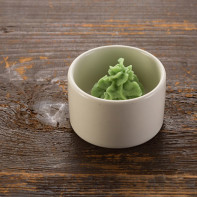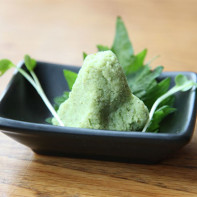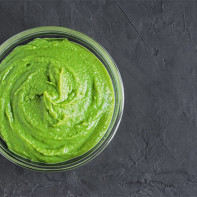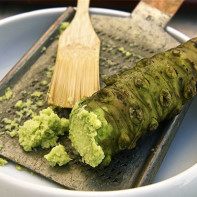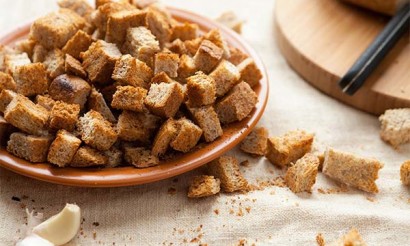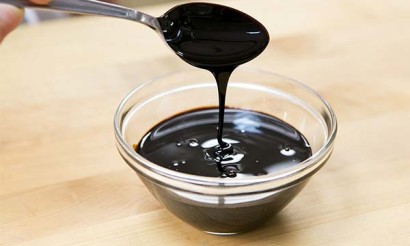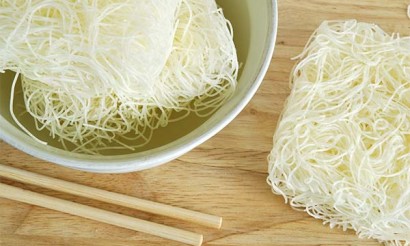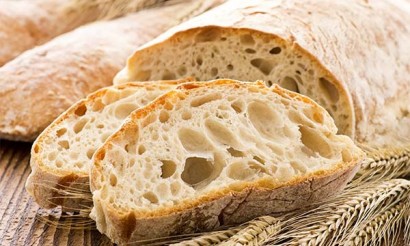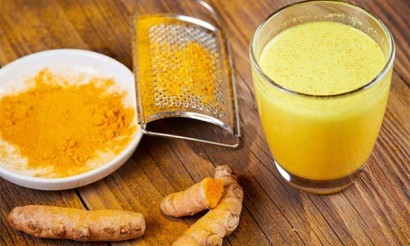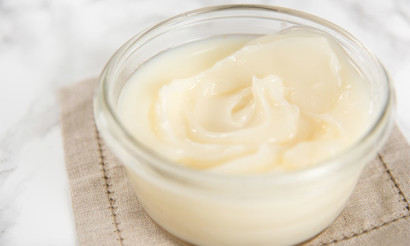Wasabi: composition, useful properties and contraindications
First of all, it is a plant, and then - the Japanese sauce of the same name. Eutrema japonica is the second name of a vegetable from the Cruciferous family, the main part of which is the root. Above the ground you can see a slightly raised creeping stem not more than one and a half meters long. Spring and summer is the time of flowering of Eutrema with small white flowers.
- What is wasabi and what is it made of
- How wasabi differs from mustard and horseradish
- Composition and calories
- Wasabi properties
- For Women
- For Men
- During Pregnancy
- Breastfeeding
- For kids
- Slimming
- Wasabi in medicine
- Wasabi in cosmetology
- For Face
- For Hair
- Cooking Uses
- What can be used as wasabi?
- Hazards and contraindications
- How to choose and store wasabi
- How to Make Wasabi at Home
- Interesting facts about wasabi
The place of growth is the mountainous prefecture of Shizuoka, rich in rivers. Flowing water and its temperature ranging from 10-17 degrees Celsius throughout the year are the prerequisites for growing the plant. In some farms hot springs are used to maintain the temperature regime. It takes 18 months until the root is fully ripe. After this period, the root becomes the raw material for the preparation of natural sauce.
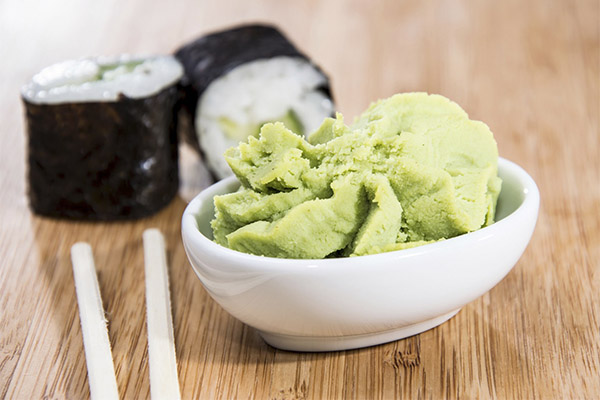
Note! While this root used to grow only on the mountain slopes of the Japanese prefecture, nowadays it has been learned to be grown by New Zealanders, inhabitants of American Oregon and Taiwan.
What is wasabi and what is it made of?
This mysterious spice is familiar to fans of Japanese cuisine: if sushi appears on the table - the bright green stinging paste is sure to be there. This Japanese sauce has become a favorite among gourmets in many countries because of its quick preparation and lack of additives.
The ripe root, thick and juicy, is plucked and grated. The interesting thing is that the resulting green mass is wasabi paste, ready to be consumed.
How wasabi differs from mustard and horseradish
This Japanese spice is different from mustard and horseradish. It is sharper and more flavorful than mustard. While the first spice has a green color, the second has a yellow color. But the main thing: mustard is a product that becomes a spice after combining the plant with additional components, while wasabi requires only the root of the plant of the same name.
Horseradish and "Japanese" are very close relatives, so the difference between them in taste is not so significant: just the Russian root vegetable is characterized by a more pleasant flavor. Its color is light brown.
In cooking, the location of the spice also differs. Wasabi is one of the best spices for fish and seafood. Mustard seeds are good in various vegetable preparations. Spicy mustard powder spice is adored by gourmets in smoked, meat, and fish dishes. Hot dishes, cold cuts, sauces, preserves - the scope of horseradish.
Composition and calories
The richness of wasabi in vitamins, trace elements, isothiocyanates and low calories make the spice very useful to the human body.
- Vitamin A is for beautiful skin and good eyesight.
- B vitamins strengthen the immune system.
- Ascorbic acid, niacin, thiamine, folic acid, pyridoxine are important for the body.
- Calcium, potassium, copper, zinc, manganese, magnesium are micronutrients necessary for normal functioning of the body.
- The spice has isothiocyanates that prevent diseases in the mouth and tooth decay.
The low caloric value (241 kcal) of the product is provided by a balanced amount of protein, fat and carbohydrates: per 100 grams of spice - 4.8 g, 0.63 g and 23.54 g, respectively.
Wasabi health benefits
The whole world knows about the high life expectancy of the Japanese and their excellent health. One of the reasons for this is the use in food spice from the root khonwasabi, or simply wasabi.
For women
- The increase of sexual desire is the result of the love of the female half of mankind to this spice.
- The product can have a beneficial effect on the body if a woman is experiencing pain during or before her period.
- In the presence of predisposition to breast cancer components of Japanese horseradish can stop their formation.
For men
For the stronger sex, wasabi is an aphrodisiac that stimulates potency. Thanks to the spice increases the blood rush to the genitals, which results in an increase in libido.
When pregnant
Expectant mothers are quite peculiar people with their caprices. And often they really want to eat sushi with wasabi. Although the Japanese spice because of its sharpness can threaten them with the appearance of heartburn, a very small amount of spice with fish will not hurt. After all, wasabi - a treasure trove of useful substances that are necessary for the mother and the unborn child. But the advice of a specialist in this situation will not be superfluous.
When breastfeeding
A breastfeeding mother can make her first attempts to use wasabi as a condiment when her baby is 3 months old. If there are no undesirable effects, moderate use of the spice will saturate the body of the mother and child inherent in it useful components.
For children
Japanese spice can cause burns of the mucous membrane of the stomach of a child, so it is recommended only for children over 8 years.
For weight loss
Accelerating the metabolism, eliminating salt, excess water, replenishing the body with many useful substances contained in the sauce, makes the spice a very necessary product for thinners. Wasabi, as a supplement to the main meal, for example, during the sushi diet, helps in getting rid of extra pounds.
Wasabi in medicine
A natural spice made from a finicky Japanese root vegetable is a healer in every sense of the word. The medicinal virtues of the sauce are not exaggerated. By many parameters it surpasses modern medicines developed by the pharmacological industry. Wasabi is the enemy of a huge number of fungi and pathogens. Circulatory vascular disorders, respiratory diseases, malignant tumors - and not only these problems in the human body can be solved thanks to wasabi.
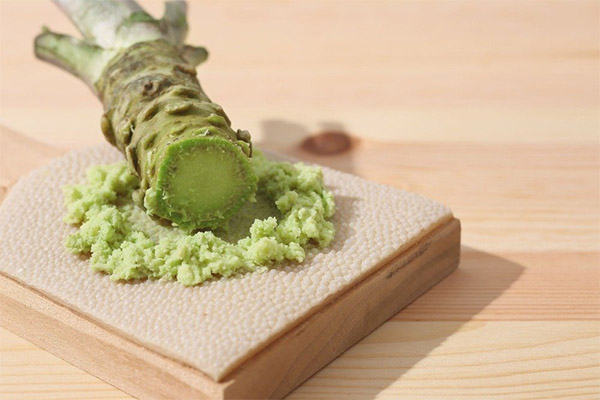
- Japanese horseradish has long been known to healers as a remedy that prolongs youth and brings longevity.
- It is also known as a cure for sinus problems, intestinal infections, and food poisoning.
- Fungal growths, staphylococcal infections, stomatitis, periodontal disease, malignant growths - extracts and infusions of Japanese root help in getting rid of these health problems.
- One of the main properties of the rhizome is considered to destroy cancer cells and prevent their reproduction. The specific taste of the spice is the presence of isothiocyanates, natural antioxidants. They stand in the way of metastases, preventing damage to healthy cells. There is evidence of a complete cure of cancer in patients who regularly eat wasabi.
- The spice is recommended by experts for asthma, a weakened immune system, reduced potency.
- Pain in the joints, swelling will help cure compresses with Japanese spice.
- Asthma and anaphylactic shock recede under the influence of isothiocyanates in the seasoning from this root vegetable.
- The absence of most Japanese caries experts attribute to the active use of domestic natural spice.
- Normal cholesterol levels, platelet adhesion prevention, improving blood flow, reducing the risk of stroke and heart attacks - all these beneficial effects has wasabi on the human body. 1 tsp of the spice daily helps in the treatment of thrombosis and myocardial infarction.
- One teaspoon of Japanese horseradish seasoning is 11% of a person's daily allowance of ascorbic acid. The spice has a beneficial effect on the body during periods of viral colds. It helps in the treatment of a fart in the throat, clearing the airways of mucus.
- The product does not allow the number of white blood cells in the blood to decrease.
The therapeutic qualities of the Japanese root vegetable are used even in the modern world, despite the abundance of industrial medicines.
Wasabi in cosmetology
Preventing rapid aging, eliminating toxins, cleansing the body and skin, stimulating blood circulation - these are the demands of clients of SPA-salons, where the spice from the Japanese root is used.
To get rid of cellulite, wasabi, orange extract, and rosemary essential oil are mixed for wraps.
The product is widely used in the production of masks, shampoos, tanning products.
For face
Wasabi powder (2-3 tablespoons), mixed with chicken yolk and a couple of teaspoons of rice flour and applied to the face, in 10 minutes will begin the process of smoothing and rejuvenation. The warming and irritating property of the burning spice in the mask helps to increase blood circulation and penetration of the beneficial substances present in the yolk. Rice flour helps to smooth the skin.
For hair
Wasabi combined with ground ginger root in white wine strengthens the hair and prevents hair loss. To prepare the product, both powders in quantities of 20 grams are poured into a hot wine in a container of dark glass. The mixture is kept in a warm place for 15-20 days. At the end of the required period strained liquid, depending on the sensitivity of the scalp, diluted with green tea, freshly brewed. The infusion is rubbed into the scalp and leave for at least 3 hours, then rinse. Already in the first minutes after applying the product you feel a rush of heat and blood to the scalp.
Such a warming effect and supply of hair follicles with useful substances gives a mask for hair with wasabi (2 tablespoons), one egg yolk, 2 tablespoons of sugar and a small amount of honey. Applied to the head, such a remedy is maintained for at least one hour and removed with lukewarm water.
The use of wasabi in cosmetology is to obtain the desired effect, provided that you observe the rules, because the severity of this spice can cause damage to the skin.
Culinary Uses
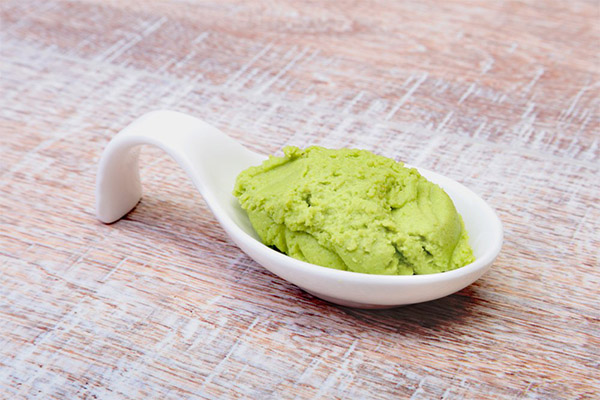
- Since the 14th century, the Japanese have been using all parts of the plant (root, leaves, stem and flowers) in cooking. Thanks to Japanese rolls and sushi, most food lovers learned about wasabi spice.
- First of all, this spice is essential in raw fish dishes: antibacterial and antifungal qualities of the paste make the food safe.
- Salads and pickles taste better when wasabi is added.
- Chicken shish kebab takes on an unusual flavor when the spice from the root vegetable is added to the marinade. To do this, olive oil, soy sauce and garlic are added to the wasabi sauce. Pour such a mixture over the pieces of meat baked in the oven. After standing for 10 minutes the shashlik absorbs the flavors and a slight burning of the spice.
- Tempura is a real Japanese dish with wasabi. It's golden in color with a crispy exterior and tender flesh on the inside. To make it, seafood and vegetables consisting of onions, celery, and sweet peppers are sliced, dried, and dipped in a batter. Flour, eggs and ice water are the components of the batter. After being dipped into the batter, the pieces are fried in boiling oil.
- The use of wasabi with fish, seafood, and rice is generally accepted and undeniable. It is not uncommon to serve fried vegetables, shrimp, sushi, and rolls with the Japanese root vegetable seasoning.
- The spice has also found use as an additive to first courses and soups. It gives them an exquisite flavor and spiciness.
- Small fried fish served chilled with wasabi is considered an excellent appetizer.
- A sandwich that is made from bread with a thin layer of this sauce, on which are arranged in layers slices of smoked mackerel, cream cheese and a thin circle of tomato, will satisfy the appetite of a spicy spice lover with the versatility of a spicy-smoked flavor.
- Wasabi is a component in the creation of original sauces and condiments combined with soy sauce, mayonnaise, mustard seeds.
- Japanese sauce now "registered" in many restaurants around the world and is present in dishes that are far from Japanese.
- For example, tomato salad with yellow, red and green tomatoes has become very popular. Wasabi, pine nuts, tarragon, green onions, salt, pepper and mascarpone (Italian cream cheese) are whipped. Dress the multicolored tomato salad with this mixture.
- A green bean salad can be offered for an amateur. For its dressing, a mixture is made by combining walnut oil, ginger, rice vinegar, lime zest, and mirin (a sweet rice wine native to Japan). After adding wasabi, the mixture is whipped. The dressing is ready.
- A pork schnitzel cooked with Japanese horseradish spice has an amazing taste. The meat is kept in the marinade for some time and baked in the oven.
- Brownies (chocolate brownie) and pannacotta (boiled cream) are trendy desserts and sweet dishes with wasabi. True, instead of the root vegetable sauce, it's better to use a powdered counterpart in the preparation of these delights.
What you can replace wasabi with
Mustard and horseradish mixed with each other can serve as a substitute for the spice. But their flavor and spiciness will not be as close to the original.
The plant's fresh root is rare on the market. But spice manufacturers offer consumers wasabi powder, tablets, and paste in tubes.
Harm and contraindications
Nature has not created a single ideal plant for humans, useful in every way. The same can be said about wasabi.
- The excessive consumption of this root vegetable can damage the liver. The hepatotoxin, a chemical element contained in the vegetable, in small doses does not pose any danger. But the liver begins to fail if there is an accumulation of this component: the body cannot cope with its processing.
- Increased blood pressure can also be the cause of excessive fondness for the seasoning.
- To avoid complications, people with signs of hepatitis, stomach ulcers, intestines, pancreatitis, should limit the use of this spicy Japanese seasoning.
- Allergic reactions can also be a reason to be cautious in using wasabi, especially for those who decide to try the product for the first time.
- The spice is contraindicated in inflammatory processes in the kidneys.
How to choose and store wasabi
The root under this name is a very expensive treat. Most often it is replaced with horseradish, although its properties are inferior to the "Japanese". Therefore when choosing a product, you should be careful not to replace one with another, cheaper and of poor quality.
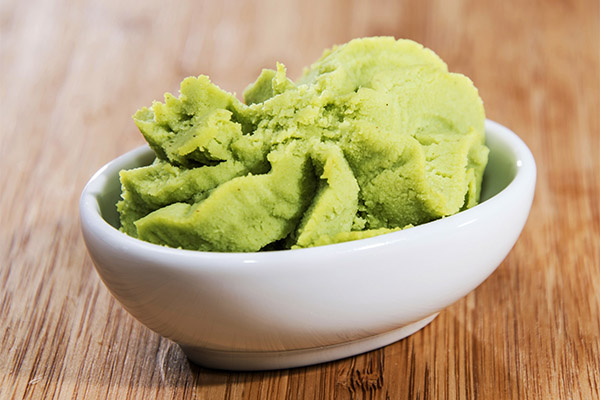
- If there is a possibility of choosing a real wasabi root, it should be fresh and not peeled. If you buy the leaves of the plant, you should follow the same rule.
- A substitute for the natural product is a paste made of it, bright green and spicy. The composition should not contain any additional components. Water, vegetable oil, E133, E102, mustard, preservatives, horseradish, flavor stabilizers - all this should be excluded from the product.
- A conscientious manufacturer of wasabi powder will indicate on the packaging the type of seasoning and the percentage of natural product content.
So, the first grade means the following: the package contains 100% natural product.
20-25% of the natural raw material is found in the second grade of the product.
The third grade is a complete wasabi substitute, which is unlikely to be healthy.
The refrigerator is the best place to store the spice. This applies to natural root, paste and powder. The maximum shelf life of powdered spice is a year and a half.
The shelf life of the sauce is short - only a few days, even if all the rules are followed. Some manufacturers use additives to increase the shelf life. Even with a shelf life of 24 months a tube of paste should be kept in the refrigerator. Unopened spice should be used within a few weeks.
The powder retains its properties much longer than the paste, if stored in a tightly sealed container.
How to make wasabi at home
The product is prepared from the fresh root, having previously cleaned it from the hard skin. On a fine grater with circular motions grate as much paste as necessary for single use. The remaining piece of raw material, wrapped in polyethylene, is placed in the fridge for no more than a month: this is how long its flavor, aroma and useful properties are preserved.
A single portion of wasabi powder is prepared in the ratio of 1 tsp. warm water and dried spice. The stirred clay-colored mixture after a 10-minute soaking will have a more pronounced flavor and aroma.
Quite a decent substitute for an exotic sauce can be a seasoning in a purely Russian style. In spice and taste it is little inferior to the "Japanese". Equal parts of mustard powder and grated horseradish root (50 gr) plus not more than 5 grams of green food coloring and the Russian equivalent of wasabi is ready.
The home-made wasabi mayonnaise is great with shrimp. To make it, an egg is beaten with 200 grams of vegetable oil. The wasabi powder dissolved in warm boiled water to a paste is combined with the beaten egg. After a short mixing with a blender add 1.5 tbsp of lemon juice, salt and pepper to taste. Such a dressing is also suitable for other seafood dishes.
Japanese natural seasoning wasabi is not just an expensive product, but also very useful for people interested not only in tasty food, but also good health.
Interesting facts about wasabi

- Japanese herbalists used the healing properties of the root vegetable already in the 7th century.
- At first, the root of the plant was used to disinfect raw fish.
- 1908 is considered the time of reference when the name of this root vegetable was first mentioned in one of the botany manuals.
- World War II made the spice a means to help Europeans transport raw fish from Japan. Since that time, wasabi has been appreciated in Europe not only as a component of many fish and meat dishes, but also as a health product. However, the real Japanese spice is Honwasabi, which is obtained from a very capricious vegetable that requires special growing conditions. That is why the spice called "wasabi", known around the world, is a product of European horseradish. Only a true gourmet can determine the difference between the real additive and its substitute, of which there are not many.
- Today, the cost of real wasabi is 200 euros per 1 kg of the root.
- In 2011, specialists in Japan invented a special kind of alarm that helps people who are deaf during a fire: the sharp smell of the plant awakens people who are asleep or do not perceive sounds.
- Among the many attractions of this mysterious country Eutrema flowers took its rightful place. Only on July 7, as the Japanese believe, you can admire its flowers. Since it is difficult to see them, it is believed that they bring wealth and respect to the lucky person.
The most important thing is that you are able to see them in the form of a spice, which is not only a wonderful spice. It is a unique therapeutic agent, the properties of which are still being studied by specialists. It is possible that in the near future many new therapeutic agents will emerge just because of wasabi.
«Important: All information on this site is provided solely for introductory purposes. Before applying any recommendations you should consult with a specialized medical specialist. specialist before applying any of the recommendations. Neither the editors nor the authors shall be liable for any possible harm caused by materials."

